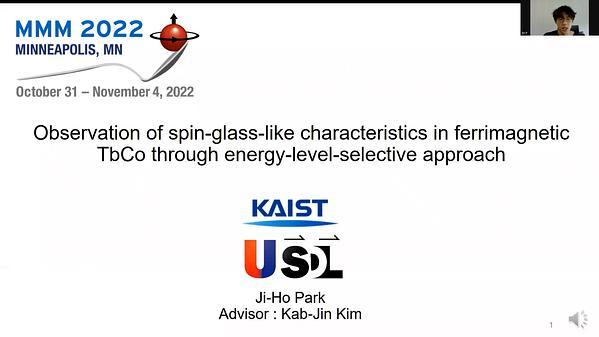
Premium content
Access to this content requires a subscription. You must be a premium user to view this content.

technical paper
Scattering Reversals and Higher Order Interactions in Three
Alex Hamill1, Tao Qu2, Randall H. Victora2, Paul A. Crowell1
1School of Physics and Astronomy, University of Minnesota, Minneapolis, Minnesota, United States,
2Department of Electrical and Computer Engineering, University of Minnesota, Minneapolis, Minnesota, United States
Abstract Body
The FMR magnon population (hereafter defined as the FMR amplitude c0) can become unstable when driven by microwave power Pa greater than a threshold power PS,such that it undergoes three-magnon splitting to two magnons c±k of half the frequency and equal and opposite wavevectors 1. We employ time-resolved homodyning spectroscopy to examine this instability over five orders of magnitude in microwave power Pa. We observe an additional threshold power Posc, above which the splitting induces oscillations in c02. At
high powers, we find that these oscillations induce 180° phase shifts in FMR. Our model predicts these phase shifts and that, similarly, the half-frequency magnons undergo 90° phase
shifts. Notably, we find that these phase shifts correspond to reversals in the three-magnon scattering direction between splitting and confluence (see Fig. 1a,b). The scattering direction is found to be determined by |Ψ0|, the absolute phase between FMR and its three-magnon scattering term. These reversals generate pronounced oscillations of the FMR amplitude after turning off the microwave excitation (see Fig. 1b,d). We also observe broadening in the frequency spectra of the oscillations (see Fig. 2a,b). From our micromagnetic simulations, we find that this corresponds to higher-order scattering processes that vary with FMR frequency (see Fig. 2c,d). These findings shed light on the relationship between three-magnon splitting and confluence, the role of phase dynamics in magnon scattering, and the higher-order magnon scattering processes at high microwave powers.
References
1 H. Suhl, J. Phys. Chem. Solids, Vol. 1, pp. 209-227 (1957)
2 T. Qu†, A. Hamill†, R. H. Victora, and P. A. Crowell, arXiv:2204.11969 (2022)
The Minnesota Supercomputing Institute (MSI) provided resources that contributed to the
research results reported within this abstract. The authors acknowledge support by SMART, a
center funded by nCORE, a SRC program sponsored by NIST. The authors also acknowledge
support by DARPA under Grant W911NF-17-1-0100, MINT at Minnesota, and the NSF
XSEDE through Allocation No. TG-ECS200001.

Fig. 1. (a,b) Numerical solutions of the magnon amplitudes c0 and ck during and after microwave excitation. Color-coding corresponds to |Ψ0|. (c,d) Corresponding experimental data of c0, showing the power dependence of the oscillations and scattering reversals. Data is normalized to the turn-on peak at 46 dB.

Fig. 2. (a,b) Measured frequency spectra of the oscillations, at various powers Pa relative to Posc, for FMR frequencies of 1.5 GHz (left column) and 2.5 GHz (right column). (c,d) the
corresponding simulated magnon amplitudes at powers below and above the onset of broadening, showing the different higher-order scattering processes at 1.5 GHz and 2.5 GHz.

